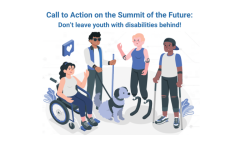[The article has been co-authored by IDA-GDI Hub Assistive Technology User Fellows on the role of assistive technology in the inclusion and participation of persons with disabilities in public life. They penned this piece based on their personal experiences as well as data gathered from AT user interviews conducted in their respective countries namely: Bangladesh, Pakistan, Peru, Sudan, and Uganda. Five fellows interacted in pairs to design interview questions and interviewed 20 AT users representing different disability constituencies including persons with albinism, persons with intellectual disabilities and deaf persons. IDA provided the Fellows with technical support and guidance notes.]
Randa Munir, a 30-year-old Sudanese woman who is hard of hearing was born into a family of three deaf sisters and one deaf brother. Her family’s economic situation, coupled with the high cost of assistive technologies, prevented regular use of hearing aids. In the early stages of secondary school, Randa had to leave inclusive education and transfer to a special school due to the inadequacy of her hearing aid. The poor quality of the device significantly impacted her academic performance. Consequently, she opted to study fine arts instead of aviation, her preferred choice, upon completing secondary school. Randa struggled to find a decent work, focusing instead on silent theatre, drawing, and painting, which did not provide sufficient income. Having been failed to manage a work supported with reasonable accommodation including assistive technology, Randa got frustrated leading to her isolation from public life.
Sabrina Mumtaz Samantha (21) and her brother Mehdi Hasan Sakif (25), both wheelchair users, face daily challenges to participate in their academic work due to limited access to AT. They find themselves heavily dependent on their mother for attending classes and doing essential daily living tasks, which is moreso for Sabrina given the additional barriers she experiences as a woman with a disability. This lack of independence hinders their academic and social participation, and limits their freedom and involvement in the community.
Fayyaz Rasool, a Deaf person, faced difficulty while he was attempting to cast his vote in the recent national election just because the election officials did recognize his need to have access to AT. He could not understand the instructions given by the polling staff due to lack of sign language interpreters and assistive technologies. The integration of assistive technology, inclusive voting technologies and sign language interpretation could support him to exercise this right to vote independently. In Peru, organizations of parents of students with intellectual disabilities organize themselves to give their children the assistive products and services that they do not find in schools. Due to non-inclusive educational settings, a high percentage of people with disabilities opt for self-employment or informal employment in Peru.
Beyond functional independence and participation, assistive technology plays a critical role in upholding the dignity and self-worth of persons with disabilities, though it also ironically carries its own stigma. Moklasur, a Bangladeshi blind youth expressed his frustration that several bus drivers used to refuse to let him board when he tried to use public transport because they assumed that he must be a beggar as he was holding a white cane in his hand.
Limited access to AT adversely affects the participation of persons with disabilities in the areas of access to information, education, employment, independent living, and political and public life. On the other hand, there are positive stories that illustrate how AT plays life-changing roles in the lives of people with disabilities.
“Access to AT such as speech-to-text software and mind-mapping software (graphic organizer) allows me to express myself, share my thoughts, and engage in class assignments and discussions like everyone else. For me AT serves as keys, unlocking a world of independence" says Ruth Akello, a high school student with intellectual disabilities. Ruth was forced to drop out of school for 3 years, but AT brought back her to education, and supported to exercise her rights to freedom of expression, autonomy, and many more civil and political rights. John Kayunga, a person with albinism, said AT solutions like specialized solar-powered glasses, augmented smartphone and sun-protective gear gave him freedom to navigate independently, work in gardening and in the afternoon he was able to walk to open his shop.
AT creates pathways to information, empowering individuals to learn, stay informed, and engage in meaningful discourse. Through the lens of diverse experiences, it is evident that AT is not merely a tool but a catalyst for breaking down barriers and empowering individuals to live fulfilling lives. As we continue to advance technologically, it is crucial to ensure that these innovations are accessible to all, leaving no one behind in the pursuit of a truly inclusive society.
